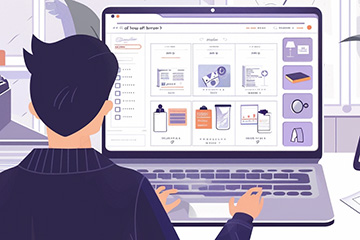Drop shipping is a great way to source products without a huge investment. Unfortunately, this seemingly turnkey model has few barriers to entry and attracts many competitors with very thin margins and no clear way to differentiate themselves.
However, it’s not impossible for aspiring entrepreneurs to launch a successful dropshipping business if they understand the challenges of growth and profit.
Boost Dropshipping
I once heard E-commerce Dropshipping It’s been described as “the perfect business model for anyone who wants to eliminate all the stress and frustration of running a business and not have to worry about profits.”
That’s a bit unfair to an industry that’s expected to generate $351.8 billion in sales in 2024, but… according to For dropship provider Oberlo, this also suggests benefits for starting or expanding a business.

There’s a reason why ecommerce dropshipping is attractive as a business model: it’s relatively easy to get started with and the risk is very low.
There are at least four reasons why entrepreneurs are attracted to dropshipping.
- Little to no investment is required. There is no need to purchase inventory in advance.
- Low risk. Merchants only pay for what they sell, so their risk is minimal.
- Access to the product. Stores can offer a variety of products without having to worry about storage or investment. When I was heading e-commerce for a retail chain, we used drop shippers to add complementary products to our site and increase our average order value.
- Flexibility. Sellers can change their product offerings based on market trends without taking on significant financial risk.
All of these features focus on sourcing the product and making financial investments, but the trade-off is marketing.
Marketing Business
Selling dropshipping products is a choice that puts the focus on attracting and converting customers, rather than developing or sourcing products.
Virtually, if you are starting or expanding your dropshipping business, Marketing Issues Rather than procuring it.
And then there are the marketing problems: the top three being limited customer acquisition, undifferentiated products, and customer relationships.
Not much CAC
Consider for a moment a traditional retailer that orders products from manufacturers at wholesale prices, stores the goods in a warehouse, and sells them for, say, a 25% margin.
That means that every $100 in sales means a gross profit of $25. Return on ad spend At 4:1, you can invest $6.25 in customer acquisition. This is your goal. Customer Acquisition Cost.
The drop shipping supply chain is longer and more expensive in comparison, as more parties receive a cut of the profits and bear the inventory risk, with some parties receiving a significant percentage.
According to Shopify, typical margins for a store selling dropshipping products can be as low as 10%, meaning that the same $100 in sales would earn them $10 in margin. With a 4:1 ROAS, this store’s target CAC would be $2.50.
If the retailer and the dropship shop are selling the same products (as is likely), the marketing challenge is obvious: the dropship store needs to attract customers at a lower price.
Same product
Selling identical products will make your already low CAC even worse, but most dropship-based stores sell identical products.

The t-shirts are available to buy on t-shirt specialist AliExpress and Dsers-AliExpress Dropshipping app.
Consider Dsers-AliExpress Dropshipping, an app for Shopify that pulls products from AliExpress and adds them directly to your Shopify store. This process can be done by any Shopify store, potentially listing the same AliExpress products in dozens or even hundreds of shops.
So, it’s not enough to just sell products from your store – running an ecommerce dropshipping business requires you to differentiate yourself from the many others out there.
Customer Relationships
Your marketing efforts don’t end once a sale is made. Some of the most effective tactics are: Retention and Engagement subsequent purchaser.
Building strong customer relationships is therefore crucial in a dropshipping business, especially when the same product may be available from multiple sources at similar prices.
That means investing time into content marketing, email marketing, retargeting, and social media marketing.








